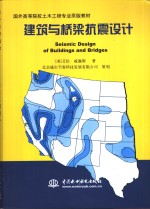

建筑与桥梁抗震设计 英文版PDF电子书下载
- 电子书积分:15 积分如何计算积分?
- 作 者:(美)艾伦·威廉斯著
- 出 版 社:北京:中国水利水电出版社
- 出版年份:2002
- ISBN:7508410009
- 页数:470 页
INTRODUCTION 1
1 GENERAL SEISMIC PRINCIPLES 7
1.1 Earthquake Phenomena 7
1.1.1 Basic Seismology 7
1.1.2 Measurement of Earthquake Magnitude and Intensity 9
1.1.3 Seismic Effects 11
1.2 Structural Dynamics 13
1.2.1 Undamped Free Vibrations 13
1.2.3 Critical Datnping 17
1.2.2 Damped Free Vibrations 17
1.2.4 Overdamping 18
1.2.5 Underdamping 18
1.2.6 Multipli-Degree-Of-Freedom Systems 21
1.3 Response Spectra 41
1.3.1 Ground Motion 41
1.3.2 Dynamic Response of Structures 41
1.3.3 Normalized Response Spectra 43
1.3.4 Near-source ground motions 45
References 46
2.1 Determination of Lateral Forces 47
2.1.1 Seismic Zone Factor 47
2.1.2 Ground Response Coefficients 47
2 STATIC LATERAL FORCE PROCEDURE FOR BUILDINGS 47
2.1.3 Soil Profile Types 48
2.1.4 Seismic Source Clasification 49
2.1.5 Near Source Factor 49
2.1.6 Fundamental Period 49
2.1.7 Ductility 52
2.1.9 Classification of Structural Systems 53
2.1.8 Response Modification Factor 53
2.1.10 Occupancy Categories and Importance Factors 56
2.1.11 Seismic Response Coefficient 57
2.1.12 Seismic Dead Load 59
2.1.13 Equivalent Lateral Force Procedure 59
2.1.14 Simplified Lateral Force Procedure 64
2.2 Multi-Story Structures 64
2.2.1 Vertical Distribution of Seismic Forces 64
2.2.2 Simplified Distribution of Base Shear 67
2.2.3 Overturning 68
2.2.4 P-Delta Effects 69
2.2.5 Story Drift 72
2.1.6 Simplified Determination of Story Drift 78
2.2.7 Diaphragm Loads 80
2.1.8 Simplified Determination of Diaphragm Loads 81
2.3 Load Combinations 82
2.3.1 Design Loads and Load Factors 82
2.3.2 Allowable Stress Design Method 88
2.4.1 Basic Components 91
2.4 Lateral Force Resistant System 91
2.4.2 Plywood Diaphragms 92
2.4.3 Collector Elements 98
2.4.4 Wood Shear Walls 101
2.4.5 Braced Frames 107
2.4.6 Moment Frames 109
2.5 Elements,Nonstructural Components,and Equipment Supported by Structures 110
2.5.1 Perfofmance Criteria 110
2.5.2 Anchorage of Conerete and Masonry Walls 110
2.5.3 Components and Equipment Supported by Structures 114
2.5.4 Wall Cladding 115
2.6 Self-Supporting Nonbuilding Structures 122
2.6.1 General Requirements 122
2.6.2 Systems Similar to Building Structures 122
2.6.3 Rigid Systems 122
2.6.4 Ground Supported Tanks 124
2.6.5 Other Nonbuilding Structures 124
2.7 Torsion and Rigidity 125
2.7.1 Rigid Diaphragms 125
2.7.2 Torsional Moment 125
2.7.3 Center of Mass and Center of Rigidity 127
2.7.4 Torsional Effects 128
2.7.5 Shear Wall Rigidity 133
2.7.6 Braced Frame Stiffness 140
2.8 Seismically lsolated Buildings 147
2.8.1 Advantages of Seismic Isolation 147
2.8.2 General Design Principles 147
2.8.3 Static Lateral Force Procedure 148
References 151
3.1.2 Selection of Lateral Force Procedure 155
3.1.1 Structural Framing Systems 155
3.1 Building Configuration Requirements 155
3 DYNAMIC LATERAL FORCE PROCEDURE FOR BUILDINGS 155
3.2 Application of Modal Analysis to Buildings 160
3.2.1 Modal Analysis Advantages 160
3.2.2 Modal Analysis Procedure 164
3.2.3 Time-history Analysis Procedure 178
References 178
4.1.1 Member Design 179
4.1 General Requirements 179
4 SEISMIC DESIGN OF STEEL STRUCTURES 179
4.1.2 Member Strength 180
4.2 Braced Frames 206
4.2.1 Concertrically Braced Frames 206
4.2.2 Eccentrically Braced Frames 226
4.3 Special Moment-Resisting Frames 236
4.3.1 Seismic Damage to Speciat Moment-Resisting Frames 236
4.3.2 Beam Details 239
4.3.3 Column Details 240
4.3.4 Girder-to-Column Connection 242
References 259
5 SEISMIC DESIGN OF CONCRETE STRUCTURES 261
5.1 Anchorage to Concrete 261
5.1.1 Design Loads 261
5.1.2 Design Strength 262
5.2 Special Moment-Resisting Frames 266
5.2.1 Design Strength 266
5.2.2 Beam Details 272
5.2.3 Column Details 274
5.2.4 Girder-to-Column Connection 284
5.3 Shear Walls and Wall Piers 289
5.3.1 Shear Capacity of Shear Walls 289
5.3.2 Boundary Members 290
5.3.3 Wall Piers 303
5.4 Walls with Out-of-Plane Loading 304
5.4.1 General Requirements 304
5.4.2 Design Strength 305
References 312
6.1 Construction Requirements 313
6.1.1 Diaphragms 313
6 SEISMIC DESIGN OF WOOD STRUCTURES 313
6.1.2 Collector Elements 315
6.1.3 Shear Walls 332
References 342
7 SEISMIC DESIGN OF MASONRY STRUCTURES 343
7.1 Shear Walls 343
7.1.1 Design Criteria 343
7.1.2 Shear Capacity 348
7.1.3 Boundary Members 348
7.2.1 General Requirements 355
7.2 Walls With Out-of-Plane Loading 355
7.2.2 Design Procedure 357
7.3 Moment-Resisting Wall Frames 365
7.3.1 Dimensional Limitations 365
7.3.2 Beam Details 366
7.3.3 Pier Details 368
7.3.4 Beam-Pier Intersection 371
References 372
8.1 Design Requirements 373
8.1.1 Load Factor Design 373
8 SEISMIC DESIGN OF BRIDGES 373
8.1.2 Service Load Design 374
8.1.3 Load Combinations 374
8.2 Design Principles 375
8.2.1 Design Procedure 375
8.2.2 Acceleration Coefficient 376
8.2.3 Elastic Seismic Response Coefficient 376
8.2.4 Importance Classification 381
8.2.5 Seismic Performance Category 381
8.2.6 Analysis Procedure 382
8.2.7 Response Modification Factors 383
8.2.8 Combination of Orthogonal Forces 387
8.2.9 Column Plastic Hinges 388
References 396
APPENDIX Ⅰ 397
List of Useful Equations 397
APPENDIX Ⅱ 405
Multiple Choice Ouestions for the Special Seismic Examination 405
APPENDIX Ⅲ 427
Structural Design Programs for the HP-28S Calculator 427
INDEX 465
- 《建筑施工企业统计》杨淑芝主编 2008
- 《指向核心素养 北京十一学校名师教学设计 英语 七年级 上 配人教版》周志英总主编 2019
- 《设计十六日 国内外美术院校报考攻略》沈海泯著 2018
- 《卓有成效的管理者 中英文双语版》(美)彼得·德鲁克许是祥译;那国毅审校 2019
- 《计算机辅助平面设计》吴轶博主编 2019
- 《高校转型发展系列教材 素描基础与设计》施猛责任编辑;(中国)魏伏一,徐红 2019
- 《景观艺术设计》林春水,马俊 2019
- 《重庆市绿色建筑评价技术指南》重庆大学,重庆市建筑节能协会绿色建筑专业委员会主编 2018
- 《高等教育双机械基础课程系列教材 高等学校教材 机械设计课程设计手册 第5版》吴宗泽,罗圣国,高志,李威 2018
- 《指向核心素养 北京十一学校名师教学设计 英语 九年级 上 配人教版》周志英总主编 2019
- 《中国当代乡土小说文库 本乡本土》(中国)刘玉堂 2019
- 《异质性条件下技术创新最优市场结构研究 以中国高技术产业为例》千慧雄 2019
- 《中国铁路人 第三届现实主义网络文学征文大赛一等奖》恒传录著 2019
- 《莼江曲谱 2 中国昆曲博物馆藏稀见昆剧手抄曲谱汇编之一》郭腊梅主编;孙伊婷副主编;孙文明,孙伊婷编委;中国昆曲博物馆编 2018
- 《中国制造业绿色供应链发展研究报告》中国电子信息产业发展研究院 2019
- 《中央财政支持提升专业服务产业发展能力项目水利工程专业课程建设成果 设施农业工程技术》赵英编 2018
- 《中国陈设艺术史》赵囡囡著 2019
- 《指向核心素养 北京十一学校名师教学设计 英语 七年级 上 配人教版》周志英总主编 2019
- 《《走近科学》精选丛书 中国UFO悬案调查》郭之文 2019
- 《清至民国中国西北戏剧经典唱段汇辑 第8卷》孔令纪 2018
